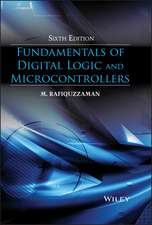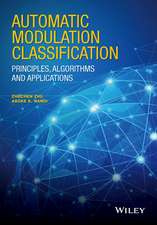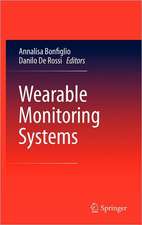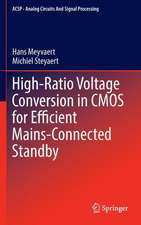Design and Analysis of High Efficiency Line Drivers for xDSL: The Springer International Series in Engineering and Computer Science, cartea 759
Autor Tim Piessens, Michiel Steyaerten Limba Engleză Hardback – 31 mar 2004
The main part of Design and Analysis of High Efficiency Line Drivers for xDSL describes the design of a novel architecture: the Self-Oscillating Power Amplifier or SOPA.
| Toate formatele și edițiile | Preț | Express |
|---|---|---|
| Paperback (1) | 638.43 lei 6-8 săpt. | |
| Springer Us – 9 dec 2010 | 638.43 lei 6-8 săpt. | |
| Hardback (1) | 646.62 lei 6-8 săpt. | |
| Springer Us – 31 mar 2004 | 646.62 lei 6-8 săpt. |
Din seria The Springer International Series in Engineering and Computer Science
- 24%
 Preț: 1041.98 lei
Preț: 1041.98 lei - 20%
 Preț: 643.50 lei
Preț: 643.50 lei - 18%
 Preț: 1225.62 lei
Preț: 1225.62 lei - 18%
 Preț: 965.02 lei
Preț: 965.02 lei - 20%
 Preț: 646.12 lei
Preț: 646.12 lei - 18%
 Preț: 948.79 lei
Preț: 948.79 lei - 20%
 Preț: 646.62 lei
Preț: 646.62 lei - 15%
 Preț: 637.46 lei
Preț: 637.46 lei - 20%
 Preț: 643.83 lei
Preț: 643.83 lei - 18%
 Preț: 949.23 lei
Preț: 949.23 lei - 20%
 Preț: 644.48 lei
Preț: 644.48 lei - 20%
 Preț: 994.92 lei
Preț: 994.92 lei - 20%
 Preț: 645.97 lei
Preț: 645.97 lei - 18%
 Preț: 946.87 lei
Preț: 946.87 lei - 20%
 Preț: 995.57 lei
Preț: 995.57 lei - 18%
 Preț: 956.99 lei
Preț: 956.99 lei - 20%
 Preț: 644.98 lei
Preț: 644.98 lei - 15%
 Preț: 649.54 lei
Preț: 649.54 lei - 18%
 Preț: 950.21 lei
Preț: 950.21 lei - 18%
 Preț: 1221.38 lei
Preț: 1221.38 lei - 18%
 Preț: 957.62 lei
Preț: 957.62 lei - 15%
 Preț: 643.99 lei
Preț: 643.99 lei - 18%
 Preț: 948.47 lei
Preț: 948.47 lei - 18%
 Preț: 947.35 lei
Preț: 947.35 lei - 20%
 Preț: 1284.65 lei
Preț: 1284.65 lei - 20%
 Preț: 1628.31 lei
Preț: 1628.31 lei - 20%
 Preț: 1285.78 lei
Preț: 1285.78 lei
Preț: 646.62 lei
Preț vechi: 760.73 lei
-15% Nou
Puncte Express: 970
Preț estimativ în valută:
123.74€ • 134.37$ • 103.95£
123.74€ • 134.37$ • 103.95£
Carte tipărită la comandă
Livrare economică 23 aprilie-07 mai
Preluare comenzi: 021 569.72.76
Specificații
ISBN-13: 9781402077272
ISBN-10: 1402077270
Pagini: 260
Ilustrații: XXII, 235 p.
Dimensiuni: 155 x 235 x 20 mm
Greutate: 0.59 kg
Ediția:2004
Editura: Springer Us
Colecția Springer
Seria The Springer International Series in Engineering and Computer Science
Locul publicării:New York, NY, United States
ISBN-10: 1402077270
Pagini: 260
Ilustrații: XXII, 235 p.
Dimensiuni: 155 x 235 x 20 mm
Greutate: 0.59 kg
Ediția:2004
Editura: Springer Us
Colecția Springer
Seria The Springer International Series in Engineering and Computer Science
Locul publicării:New York, NY, United States
Public țintă
ResearchCuprins
Preface. List of Figures. List of Tables.- 1: Introduction. 1. Motivation of the Work. 2. Organisation of the Book.- 2: Traditional xDSL Line Drivers. 1. Broadband Communication Technology. 2. The Channel. 3. Modulation Techniques. 4. Driving the Line. 5. Solutions for xDSL Line Drivers. 6. Conclusions.- 3: Describing Function Analysis. 1. Non-linear Systems. 2. The Describing Function Method. 3. Conclusions.- 4: Behavioural Modelling of the SOPA. 1. Reference Model. 2. Zeroth Order SOPAs. 3. Higher Order SOPA Amplifiers. 4. Final Remarks and Conclusions.- 5: Design Plan and CAD Tools. 1. Design Plan Synthesis. 2. CAD-tools to Support the Design Methodology. 3. Conclusions.- 6: Realisations in Mainstream CMOS. 1. A Zeroth Order SOPA. 2. A Third Order SOPA in .35 mum CMOS. 3. Conclusions.- 7: Conclusions. 1. The Objectives. Glossary. Appendices.- A: Stability Analysis of the Coupled SOPA. 1. Stability Criterion. 2. Polar Form of the Coupled Open Loop Transfer Function. 3. Calculation of the Stability Conditions.- References.- Index.






















